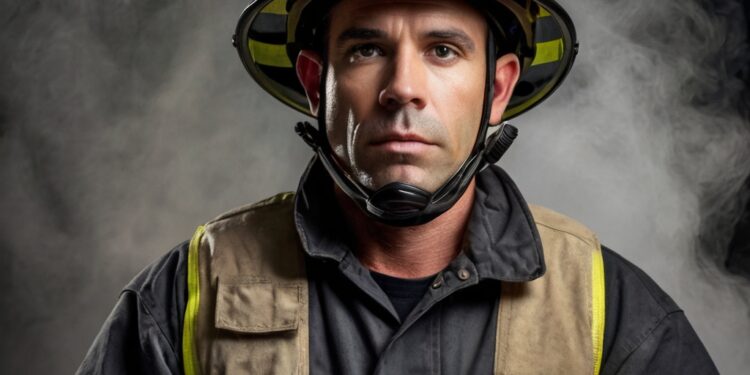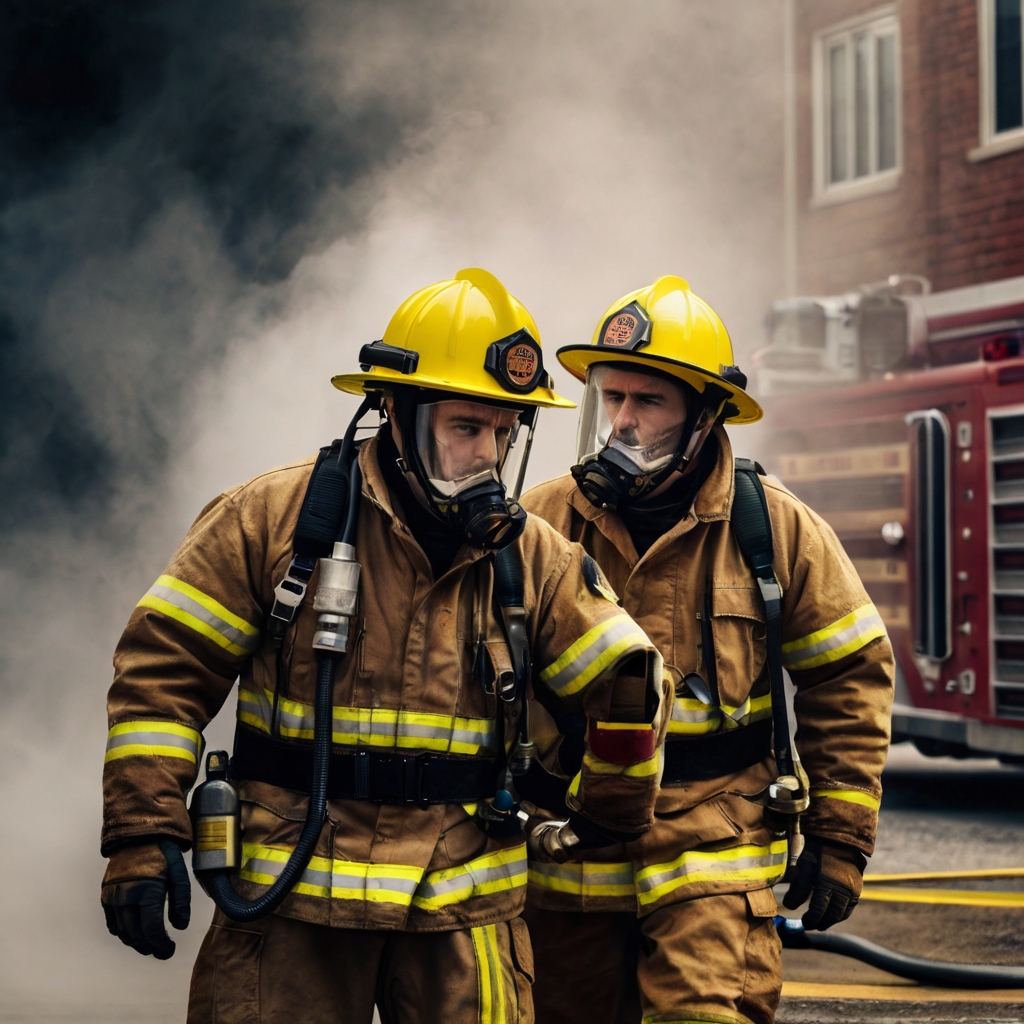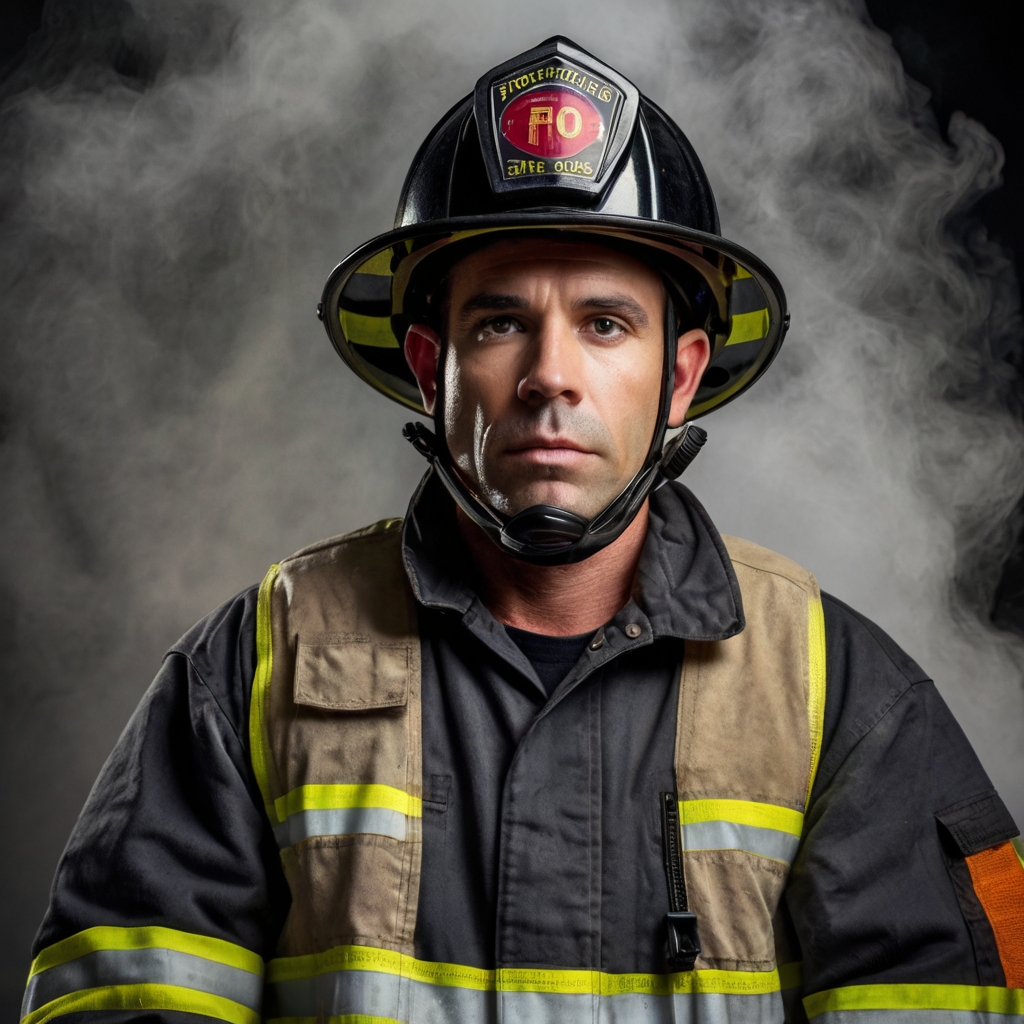Do Firefighters Have to Shave

Firefighters need to shave their faces, and it’s not just about looking neat. The biggest problem is safety. A firefighter’s facial hair can get in the way of their Self-Contained Breathing Apparatus (SCBA) mask’s proper fit and seal. This equipment keeps them safe in dangerous situations.
The rules are clear in many countries. The United Kingdom, Canada, and America require firefighters to keep their faces mostly clean-shaven, especially below the lips. These rules follow the Occupational Safety and Health Administration’s guidelines. Beards create gaps between the SCBA mask and skin that could let smoke seep in. This puts firefighters at risk in smoke-filled environments.
The debate about facial hair rules has sparked many discussions over the last several years. Some have challenged these regulations in court based on constitutional rights. These include freedom of speech, freedom of expression, privacy rights, and due process. Medical conditions also complicate the issue. Pseudofolliculitis Barbae (PFB), which affects African Americans more than other groups, has led some firefighters to ask for exceptions. These requests often end up in legal battles.
Table of Contents
- 1
- 2 The Real Reason Firefighters Must Shave
- 3 Understanding OSHA and NFPA Regulations
- 4 Legal Challenges and Religious Exemptions
- 5 Department Policies and Local Variations
- 6 Can the Rules Change in the Future?
- 7 Summing all up
- 8 Here are some FAQs about if do firefighters have to shave:
- 8.1 Can a firefighter have a beard?
- 8.2 Can I have long hair as a firefighter?
- 8.3 Do I have to shave my hair to be a firefighter?
- 8.4 Why do firefighters need to shave?
- 8.5 Can I have tattoos as a firefighter?
- 8.6 Can a firefighter have dreadlocks?
- 8.7 Can you have long hair as a cop?
- 8.8 Can I dye my hair as a firefighter?
The Real Reason Firefighters Must Shave
Safety requirements for firefighters go beyond just staying fit and training hard. Many people ask why fire departments nationwide require their firefighters to be clean-shaven. The answer isn’t about looks or tradition – it’s pure safety science.
Why a clean shave matters for safety
Firefighters need reliable breathing protection when they face dangerous conditions. Facial hair can make this protection fail, which puts lives at risk. Research shows that beards reduce how well respirators work by a lot. A key study revealed that bearded workers using half-mask respirators scored just 12 on fit tests, while clean-shaven workers scored 2,950 – that’s 246 times better protection. The numbers for full facepiece respirators tell an even bigger story: bearded workers scored only 30, but clean-shaven firefighters topped 10,000 – at least 330 times better.
The evidence doesn’t stop there. Another study that looked at firefighters found those with beards leaked air at rates 10 times higher than their clean-shaven teammates. The researchers concluded that “beards can be life-threatening during fire extinguishing activities, and during overhaul operations”.
Fire departments strictly enforce clean-shaven rules for these reasons:
- Air supply problems: Masks that leak mean firefighters don’t get enough air. This can lead to dizziness, confusion, and blackouts – the last things you want in a burning building.
- Toxic exposure: Any break in the seal lets smoke in, which can harm health long-term.
- Gear issues: Beards don’t just mess with breathing masks – they can get in the way of helmets and hoods too.
These rules aren’t just department priorities – they’re federal safety requirements.
How facial hair affects SCBA mask seal
The science here is clear. Tight-fitting respirators need perfect contact with skin to protect you. Even a little facial hair can break that seal and let dangerous particles slip through.
The Centers for Disease Control warns that “Even a day or two of stubble can reduce protection”. Hair creates tiny gaps between the respirator and skin that let contaminated air sneak in. The seal fails as soon as hair grows into the area where the respirator should touch the skin.
OSHA’s Respiratory Protection Standard (29 CFR 1910.134) says workers can’t wear tight-fitting respirators if any hair grows between their skin and the mask’s sealing surface. This rule exists because tests repeatedly show that people with beards fail respirator fit checks.
Australian standards say the same thing. They point out that “beard growth, some hairstyles and other facial features prevent an adequate seal between the wearer’s face and the fitting surfaces”. Their guidelines state clearly that “bearded persons cannot expect to achieve adequate respiratory protection when wearing a full facepiece or a half facepiece RPE”.
That’s why most departments require operational firefighters – the ones who fight fires and rescue people – to stay clean-shaven, especially below their top lip. This isn’t about looks – it’s about making sure their life-saving equipment works properly.

Understanding OSHA and NFPA Regulations
Fire departments nationwide follow strict rules about facial hair. These rules aren’t random – they come from years of research and real-world experience.
OSHA rules on respirator fit
OSHA sets clear guidelines about respirator use through its Respiratory Protection Standard (29 CFR 1910.134). The standard makes it clear that workers can’t wear tight-fitting respirators if they have facial hair between the mask’s sealing surface and their face.
OSHA’s mandatory fit testing procedures (Appendix A) spell this out: “The test shall not be conducted if there is any hair growth between the skin and the facepiece sealing surface, such as stubble beard growth, beard, mustache or sideburns which cross the respirator sealing surface”. This rule applies to every OSHA-approved fit test.
A 2016 OSHA letter gives more detail: “Facial hair is allowed as long as it does not protrude under the respirator seal, or extend far enough to interfere with the device’s valve function. Short mustaches, sideburns, and small goatees that are neatly trimmed so that no hair compromises the seal of the respirator usually do not present a hazard”.
Fire company officers must test respirator fit yearly for all users. They need to run additional tests if physical changes might affect how well the respirator fits. Officers should test fit any time a firefighter shows up with new facial hair.
NFPA 1500 and SCBA compatibility
NFPA standard 1500 works alongside OSHA rules to create complete safety guidelines for fire departments. NFPA 1404’s stance on SCBA training and use leaves no room for doubt: “Beards or facial hair that interferes with the face piece seal shall be prohibited for members required to use respiratory protection”.
Fire departments need programs that cover how to pick, maintain and use respirators, including SCBA devices. These programs must follow NFPA 1852 and NFPA 1989’s standards for breathing air quality.
SCBA equipment must meet NFPA 1981 requirements. Their certifications need to be at least as current as that standard’s 1992 edition. Full facepiece air-purifying respirators work only in safer conditions and just for specific certified contaminants.
Are firefighters allowed to have beards?
The quick answer is no – at least not for firefighters who work inside burning buildings. OSHA rules and NFPA standards don’t allow facial hair that gets in the way of respirator seals.
Some exceptions do exist. Courts have made allowances based on job types. To cite an instance, see the Third Circuit’s ruling that shaving wasn’t “generally applicable” for a firefighter who avoided interior firefighting, hadn’t used an SCBA since 2015, and didn’t get regular fit tests.
Medical conditions deserve special attention. African American firefighters with Pseudofolliculitis Barbae (PFB) got permission to keep short facial hair in some departments. A federal judge even ordered FDNY to bring back these allowances if they don’t cause mask leaks.
Most legal challenges to clean-shaven policies don’t succeed. The Second Circuit Court of Appeals found that since everyone must follow OSHA rules, departments can’t reasonably ignore them. The Jones case backed this up: “Title VII does not require employers to depart from binding federal regulations. Legally binding federal regulations present a complete defense [to discrimination claims]”.
Departments must check if they can assign firefighters who need accommodations to safer environments without disrupting operations.
Legal Challenges and Religious Exemptions
Firefighters who want to keep their facial hair have fought many legal battles over the last several years. These challenges show the clash between safety rules and personal rights.
Notable lawsuits and court rulings
Legal battles against facial hair policies started in 1970. Back then, firefighters based their claims on constitutional rights of expression and due process. Recent landmark cases have altered the map of these regulations. A federal judge ruled in 2007 that Washington D.C.’s Fire Department broke the Religious Freedom Restoration Act (RFRA). The department had enforced its grooming policy against firefighters whose religious beliefs required beards. This led to permanent protection for several Muslim and Jewish firefighters.
All the same, D.C. Fire and EMS brought back a similar policy in 2020 during the COVID-19 pandemic. They cited N95 mask requirements as the reason. The department moved affected firefighters to desk jobs, which meant less overtime and worse schedules. The U.S. Court of Appeals for D.C. Circuit reversed a lower court’s decision in January 2025. This revived their civil lawsuit that asked for damages because of the 2007 injunction violation.
There’s another reason this issue matters. The Third Circuit partly reversed a district court’s ruling in Atlantic City. This brought new life to a Christian firefighter’s religious accommodation claims. The court said the city’s grooming policy wasn’t “generally applicable” because it let administrative staff have exceptions but denied religious ones.
Religious freedom vs. safety compliance
Courts now look more carefully at facial hair policies that affect religious practices. Departments must prove they have good reasons and use the least restrictive ways to meet safety goals.
Courts want to know if departments have tried options like:
- Letting bearded firefighters work in administrative or support roles
- Testing mask fit with facial hair
- Looking into different mask technologies
Courts have made it clear that “religious liberty is our first freedom” and “so long as the government can achieve its interests in a manner that does not burden religion, it must do so”.
Medical conditions like pseudofolliculitis barbae
Pseudofolliculitis Barbae (PFB) causes more legal challenges. This painful skin condition affects 45% to 85% of Black men. People with PFB get severe bumps, scars, and skin problems when they shave with a razor.
Four African American FDNY firefighters with PFB won a big case in 2021. They got permission to keep “closely-cropped facial hair, uncut by a razor”. The Second Circuit Court of Appeals later ruled that OSHA compliance was mandatory. This meant departments couldn’t ignore federal rules, even for medical conditions.
Some departments still give limited exceptions to PFB sufferers who pass mask fit tests. These ongoing legal fights show how hard it is to balance safety rules with creating welcoming environments in emergency services.
Department Policies and Local Variations
Fire departments in the United States handle their facial hair policies differently. Safety concerns, however, remain the same across the nation.
Do all fire departments require shaving?
Career, combination, and volunteer fire departments share similar facial hair requirements. A Firehouse.com poll of 5,598 firefighters showed different approaches to this policy. The results revealed that 7.1% banned facial hair completely, while 67.1% allowed only mustaches. Another 6.9% permitted neat beards and goatees. The remaining departments either had no policy (15.7%) or other arrangements (3.2%).
Firefighters who use Self-Contained Breathing Apparatus (SCBA) in dangerous environments need yearly fit testing. Department policies state that fit testing works only when firefighters show up without facial hair where the SCBA mask seals. Testing agencies could break OSHA standards if they test subjects who have facial hair in the sealing area.
Can firefighters have goatees or mustaches?
Most fire departments allow mustaches as long as they don’t affect the respirator seal. A neat mustache that stays above the lip line and away from the mask’s sealing area meets the standard requirements.
Many departments also limit hair thickness to 2 inches. Hair on the side of the head must not go below the ear’s bottom. Female firefighters follow similar rules but can tie up their hair to meet these requirements.
Differences between field and office roles
Not every firefighter position needs SCBA use. Bearded firefighters who respond to fires, hazardous material incidents, or confined space rescues should work only outside dangerous areas.
Some fire departments give other options by assigning non-IDLH (Immediately Dangerous to Life and Health) duties to firefighters with facial hair. Many departments find these arrangements challenging because they need constant monitoring of bearded firefighters at emergency scenes. Departments that get requests for medical or religious accommodations should talk to labor attorneys who know about firefighting hazards and employment law.
Can the Rules Change in the Future?
Firefighting equipment keeps getting better, and people wonder if the old rules about facial hair might change. New innovations show promise, but safety remains the top priority.
Technological advancements in SCBA design
Self-Contained Breathing Apparatus (SCBA) technology has come a long way. Today’s units feature up-to-the-minute data analysis capabilities with sensors that detect changes in air quality and warn users about dangerous conditions. Many models now include GPS tracking features that let commanders keep tabs on firefighter locations during operations.
These devices now run much longer than before. Modern models can operate for up to 12 hours straight – this is a big deal as it means that they last far longer than older versions. The designs have improved too, with cushioned shoulder straps and waist belts that spread weight evenly to make extended wear more comfortable.
The future of SCBA development focuses on three key areas: artificial intelligence, machine learning, and augmented reality integration. These technologies give firefighters practical sensor data and project vital information right into their field of vision.
Calls for OSHA to reevaluate standards
People who want changes to facial hair restrictions have found that courts point them toward changing OSHA’s respiratory protection standards. The National Institute for Occupational Safety and Health (NIOSH) would need to do more research to assess these safety concerns.
Firefighters have argued in several court cases that better SCBA designs have solved the safety issues related to facial hair. Notwithstanding that, courts have stayed away from reviewing scientific research in this area. They say OSHA’s rulemaking process should handle these questions.
Balancing safety with inclusivity
The debate about facial hair policies touches on both safety needs and workplace inclusion. A recent case showed how a firefighter with locs hairstyle passed all required SCBA respirator fit tests, which proves alternative hairstyles can work safely with equipment.
Some people think strict grooming rules go beyond safety concerns. A legal director put it this way: “When an employee meets every performance and safety standard but is still targeted because of their hair, it is clear the policy is not about safety—it is about exclusion and control”.
Science should guide these decisions. Clean-shaven requirements should stay where needed for safety. But rules need updates to match what we know now and what modern equipment can do.
Summing all up
Safety drives firefighter shaving rules, not looks or personal priorities. Studies show facial hair can make respirator seals dangerously ineffective during emergency responses. Research proves beards and other facial hair reduce protection substantially. Bearded firefighters face up to 330 times less protection from their respirators.
OSHA regulations and NFPA standards ban facial hair that affects respirator seals, and with good reason too. Some firefighters have challenged these rules through legal channels, especially when they have religious obligations or medical conditions like Pseudofolliculitis Barbae. Courts usually support safety requirements as the top priority. Notwithstanding that, firefighters in administrative or non-IDLH roles where respirators aren’t needed can get some exceptions.
Fire departments enforce facial hair policies differently. Most allow well-trimmed mustaches that don’t affect mask seals. The main difference comes down to whether the role needs SCBA use or not, which creates more flexibility for some positions.
New SCBA technology might change these rules in the future. Of course, equipment keeps improving with up-to-the-minute data analysis, GPS tracking, and better ergonomics. Newer mask designs could possibly work with some facial hair. Until OSHA reviews its standards based on solid scientific evidence, safety will shape grooming policies for firefighters across the country.
Firefighters must choose between personal grooming and life-saving equipment effectiveness. This reflects their profession’s core mission: protecting both the public and fellow firefighters in emergencies.
Here are some FAQs about if do firefighters have to shave:
Can a firefighter have a beard?
Most fire departments require clean-shaven faces or very short beards due to safety concerns about proper respirator seal. While some departments may allow neatly trimmed beards, the question do firefighters have to shave their beards typically yields a “yes” for operational personnel. This policy ensures their breathing apparatus can form an airtight seal during emergencies.
Can I have long hair as a firefighter?
Long hair is generally discouraged in firefighting as it can interfere with protective equipment and pose safety risks. While not all departments require crew cuts, hair must typically be kept short enough to not compromise the seal of safety helmets or breathing apparatus. The policy is less strict than do firefighters have to shave their head requirements but still maintains safety standards.
Do I have to shave my hair to be a firefighter?
Most departments don’t require completely shaved heads, despite the common question do firefighters have to shave their head. However, hair must be kept short enough to allow proper equipment fitting and prevent safety hazards. The regulations are more about practicality than the extreme of full head shaving.
Why do firefighters need to shave?
The primary reason why do firefighters have to shave daily relates to ensuring an airtight seal for their SCBA (Self-Contained Breathing Apparatus). Facial hair can prevent the mask from sealing properly, which is why do firefighters have to shave becomes a critical safety protocol. This requirement helps protect them from smoke inhalation and toxic gases.
Can I have tattoos as a firefighter?
Many fire departments now allow tattoos, though policies vary regarding size, content, and visibility while in uniform. Unlike the strict do firefighters have to shave rules, tattoo policies have become more lenient in recent years. Offensive or extremist tattoos are typically prohibited regardless of department.
Can a firefighter have dreadlocks?
Dreadlocks may be permitted if they can be contained within the helmet without compromising safety equipment. This differs from why do firefighters have to shave facial hair requirements, as head hair policies are often more flexible. Departments typically evaluate hairstyles on a case-by-case basis for safety compliance.
Can you have long hair as a cop?
Police departments generally have more lenient hair policies than fire departments, where do firefighters have to shave daily is standard. Many police agencies allow long hair if kept neat and professional-looking, often requiring it to be tied back. The differing standards reflect the distinct safety requirements between the professions.
Can I dye my hair as a firefighter?
Most fire departments allow dyed hair as long as it maintains a professional appearance, unlike the strict why do firefighters have to shave regulations. However, unconventional colors (bright pink, blue, etc.) may be prohibited depending on department policy. The focus remains on maintaining a professional image while ensuring safety isn’t compromised.


